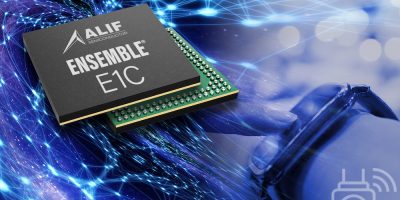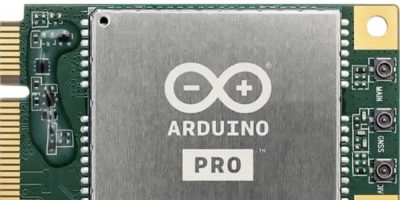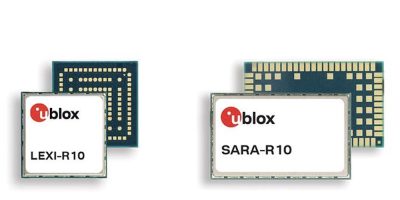Alif Semiconductor has launched the Ensemble E1C, an MCU series which combines rich digital and analog capabilities with a low-power on-chip neural processing unit (NPU) in a new compact form factor.
This new Ensemble family MCU, which combines a 160MHz Arm Cortex-M55 CPU core with Helium vector processing extension, an Arm Ethos-U55 NPU generating up to 46 GOPs, and up to 2MB of tightly coupled SRAM, is available in a tiny WLCSP package occupying a footprint of 3.9mm x 3.9mm.
The introduction of the E1C extends the Ensemble family, providing a new entry-level option for OEMs that want AI performance and ultra-low power consumption implemented in a familiar Arm environment. The new E1C also shares the same architecture as the Balletto family, allowing for software re-use across the entire family, and easy migration of applications from one device to another.
The E1C can perform both AI/ML and application control functions at ultra-low power levels. This means manufacturers can bring advanced ML capabilities to products such as wearable devices that have extreme constraints on power and space. The E1C’s capabilities are optimised for local ML workloads such as object recognition, speech recognition, sensor fusion, and adaptive audio noise cancellation, easing heavy dependence on the cloud to provide a better user experience.
The high AI performance of the E1C is matched by its power efficiency. The E1C’s aiPM technology can dynamically power only the logic and associated memory that are in use at any given time, thus achieving the lowest overall system power consumption. The aiPM power management unit implements four system-level power modes including a Stop mode which draws just 700nA.
The Ethos-U55 NPU performs 128 MACs/cycle to give ML output of 46 GOPS, and enables on-the-fly weight decompression. This results in inferencing performance some 100x faster and more power-efficient than competing MCUs based on an Arm Cortex-M4 CPU provide. The E1C’s digital cores are backed by up to 2MB of MRAM non-volatile memory alongside up to 2MB of zero wait-state SRAM. A high-speed OctalSPI interface enables expansion to external memory if required. Versions of E1C devices are offered with and without the NPU.
The E1C features a rich set of analog and connectivity peripherals. Two 12-bit SAR ADCs and a 24-bit sigma-delta ADC, a 12-bit DAC and an internal reference voltage provide for fast, precise processing of signals from external sensors. Outputs can be displayed on rich colour displays using a MIPI DSI display interface.
A broad selection of serial communications interfaces includes USB 2.0, SDIO, 2x CAN FD and I3C. Designers of connected devices can also benefit from the same low-power and high-performance characteristics of the E1C with the addition of built-in Bluetooth Low Energy connectivity by choosing the Balletto B1, launched by Alif on 9 April 2024.
Security is a core attribute of the Ensemble family, and the E1C shares the same architecture. Its advanced secure enclave, which provides a solid hardware root-of-trust enabling secure key generation and storage, secure boot, cryptographic accelerators, and certificate management, eliminates the need for an external Secure MCU in endpoint AI devices.
Latest News
Arduino’s Pro 4G module delivers fast and reliable 4G connectivity worldwide
Mouser Electronics, is now stocking the Pro 4G module from Arduino. Powered by a Quectel LTE Cat 4 modem, the Pro 4G module’s fast data throughput and high bandwidths ensure reliable and quick data download and upload, even in remote locations. The Pro 4G Module expands the connectivity capabilities of Portenta boards for use in smart city infrastructure, industrial automation, fleet management systems, remote maintenance, and other applications.
The Arduino Pro 4G module, now available at Mouser, guarantees reliable 4G connectivity and backward compatibility with existing 2G and 3G networks. The Arduino Pro 4G module connects devices through Arduino Cloud, simplifying error analysis, firmware updates, and remote maintenance. For larger projects such as smart buildings, the modules can be used to remotely monitor temperature, moisture, and deformity levels, accelerating response times when safety is at risk. The Pro 4G module is also an effective connectivity solution in challenging environments, providing long-range coverage and secure data transfer both indoors and outdoors.
Developed in the widely accepted Mini PCIe form factor, the Pro 4G module is compatible with a range of devices for applications, including pipeline monitoring, smart parking, and waste management.
u-blox announces new ultra-compact LTE Cat 1bis cellular modules
u-blox has announced an expansion to its range of R10 products for the fast-growing LTE Cat 1bis cellular connectivity market. Predicted by analyst firm Techno Systems Research Co., Ltd to account for 43.6% of all non-handset cellular devices by 2029, LTE Cat 1bis is expected to be the best-selling cellular technology for the Internet of Things (IoT) for the next four to five years.
The new u-blox LEXI-R10 Global provides an ultra-compact 16 x16mm LTE Cat 1bis solution that can be used worldwide in size-constrained IoT applications such as people or pet trackers and wearables. The LEXI-R10 Global is the world’s smallest single-mode LTE Cat 1bis module with indoor location and a US MNO certified core.
Meanwhile, the new SARA-R10 series brings the same capabilities as the LEXI-R10 Global to u-blox’s popular SARA form factor. With 2G and 3G sunsets continuing globally, the SARA-R10 offers product designers using 2G and 3G u-blox SARA modules a straightforward upgrade path to 4G LTE – the most widely available global cellular standard today and for many years to come.
The LEXI-R10 and SARA-R10 offer the option to embed an eSIM, and both modules also include an integrated Wi-Fi Sniffer, providing Indoor localisation via the u-blox CellLocate service based on both a Wi-Fi and cellular networks.
One of the variants is the SARA-R10M10, the world’s smallest LTE Cat 1bis module with embedded Global Navigation Satellite System (GNSS) capable of concurrent communication and tracking. It is the ideal solution for asset tracking and telematics applications that demand continuous connectivity as well as indoor and outdoor positioning anywhere in the world, thanks to the blend of GNSS, Wi-Fi scan and global LTE coverage. This module is also 50% smaller than u-blox’s previous LTE Cat 1bis combo, the LENA-R8M10.
The new u-blox R10 modules give product designers a 4G cellular connectivity solution for IoT applications that require medium data rates, worldwide portability, ultra-low power consumption and compact sizes.
TI unveils industry’s first GaN IPM to enable smaller, more energy-efficient high-voltage motors
Texas Instruments has introduced the industry’s first 650V three-phase GaN IPM for 250W motor drive applications. The new GaN IPM addresses many of the design and performance compromises engineers typically face when designing major home appliances and heating, ventilation and air-conditioning (HVAC) systems. The DRV7308 GaN IPM enables more than 99% inverter efficiency, optimised acoustic performance, reduced solution size and lower system costs.
Worldwide efficiency standards for appliances and HVAC systems such as SEER, MEPS, Energy Star and Top Runner are becoming increasingly stringent. The DRV7308 helps engineers meet these standards, leveraging GaN technology to deliver more than 99% efficiency and improve thermal performance, with 50% reduced power losses compared to existing solutions.
In addition, the DRV7308 achieves industry-low dead time and low propagation delay, both less than 200ns, enabling higher pulse-width modulation (PWM) switching frequencies that reduce audible noise and system vibration. These advantages plus the higher power efficiency and integrated features of the DRV7308 also reduce motor heating, which can improve reliability and extend the lifetime of the system.
Supporting the trend of more compact home appliances, the DRV7308 helps engineers develop smaller motor drive systems. Enabled by GaN technology, the new IPM delivers high power density in a 12mm-by-12mm package, making it the industry’s smallest IPM for 150W to 250W motor-drive applications. Because of its high efficiency, the DRV7308 eliminates the need for an external heatsink, resulting in motor drive inverter printed circuit board (PCB) size reduction of up to 55% compared to competing IPM solutions. The integration of a current sense amplifier, protection features and inverter stage further reduces solution size and cost.
About Smart Cities
This news story is brought to you by smartcitieselectronics.com, the specialist site dedicated to delivering information about what’s new in the Smart City Electronics industry, with daily news updates, new products and industry news. To stay up-to-date, register to receive our weekly newsletters and keep yourself informed on the latest technology news and new products from around the globe. Simply click this link to register here: Smart Cities Registration







